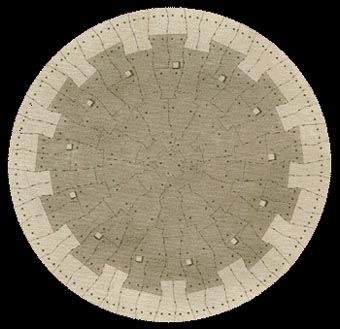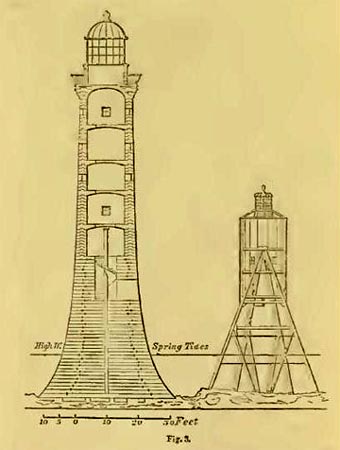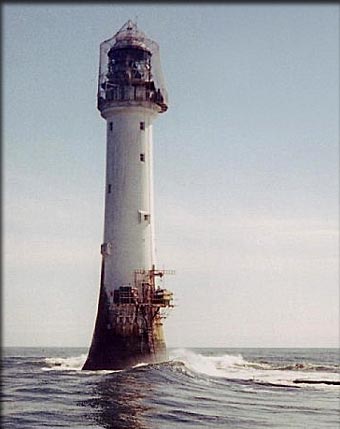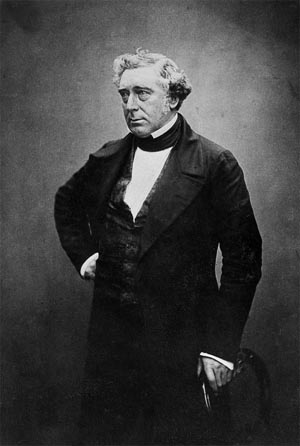 |
Building
the
Bell Rock Lighthouse
|
In December
of 1799, a terrible storm hit the northeast coast of England
and Scotland. Monstrous seas ripped ships from their moorings
and slammed them up against the coast. Out in the deep water,
ships still at sea were tossed and crushed by gigantic, violent
waves. By the time the storm let up after three days some 70
ships had been sunk and the lives of many seafaring men had
been lost.
In Scotland,
the Firth of Forth, the bay of Scotland's River Forth, would
have provided a haven for many ships in danger from that terrible
storm. However, none dared approach it because of a treacherous
quarter-mile-long reef there called the Bell Rock. Emerging
from the water for only short periods during the day, most of
the time Bell Rock lay invisible just below the waves, ready
to rip the bottom out of any ship that made for the safety of
the bay. The rock was considered so dangerous that many ships
chose to risk riding the storm out at sea rather than try to
make it past the reef to safety.
The
Abbot's Bell
Fear
of the reef (which was also known by the name of Inchcape Rocks)
was instilled in sailors long before the great storm of 1799.
According to some sources in the 14th century, the Abbot of
Aberbrothock, John Gedy, and some of his monks sailed out to
the rock with an enormous bell. They successfully attached it
to the reef so that the waves would make it ring continually,
giving ships an audible warning. The bell stayed on the rock
for only one year, however, before it was stolen by the Dutch
pirate "Ralph the Rover." Ironically, according to the story,
the pirate himself perished on the rock when his ship broke
upon it because he had taken the warning bell.
|
Seven
Quick Facts
|
| -Location:
On the Bell Rock reef 11 miles off the Northern Coast
of Scotland. |
| -Height:
From the foundation to top is 115 feet, 10 inches (35m). |
| -Made
of: Granite and Sandstone. |
| -Construction
Dates: August 1807 to February 1811. |
| -Construction
Crew: Approximately 110 men. |
| -Cost:
£61,331 |
| -Other:
Construction of the lighthouse claimed 5 lives.
|
The
bell had one lasting effect, however. It gave the dangerous
reef a name that would last through the centuries.
No further
attempts were made to place a warning device on the rock for
hundreds of years. In the late 18th century, however, the Northern
Lighthouse Board was established. By 1795 there were seven major
lighthouses along the coast of Scotland. However, the Bell Rock,
which was under sixteen feet of water at high tide, was still
considered by almost everyone too difficult a place upon which
to build a lighthouse.
Robert
Stephenson
However
a young engineer named Robert Stephenson felt differently. Stephenson
was employed by the Board to inspect and repair the existing
lighthouses and survey locations for new ones. He was intrigued
with the idea of placing a light on Bell Rock, but many members
of the board felt that it was simply impossible and would not
entertain his proposals. The disastrous storm of 1799, however,
showed that many ships and lives might be saved if only a warning
light could be built on the reef. In October of 1800, Stephenson
finally found a fisherman brave enough to take himself and architect
James Haldane the 11 miles out to the rock for a couple of hours
to take a closer look at it.
The
pair found that the part exposed at low tide was about 250 feet
long, 130 feet wide and composed of sandstone. Stephenson had
gone out to the rock expecting to build a structure over it
supported by pillars, but then determined after his examination
that these would never stand the pounding of the storm waves.
Instead, Stephenson decided to take a page from the book of
engineer John Smeaton who designed the Eddystone Lighthouse
near the port of Pymouth.
|

A
diagram showing the interlocking stones at the base of
the lighthouse.
|
The
Eddystone Lighthouse had been built in 1759 on an exposed rock
that was swept by the sea. Two earlier lighthouses on the same
location had tragically collapsed, but in his design Smeaton
had used a clever scheme of interlocking heavy granite blocks
with dovetail joints and marble dowels to ensure that the stones
could not be pulled apart even by the most powerful waves. He
also gave the lighthouse an inward, curved shape similar to
an oak tree trunk which he thought would resist the sea. His
structure was successful and inspired Stevenson to use a similar
design on Bell Rock.
However,
the Bell Rock construction would be considerably more difficult
than what had been done at Eddystone. The rock at Eddystone
was above sea level under normal conditions whereas Bell Rock
was covered by nearly 16 feet of water at high tide and was
only four feet above the waves at low tide. This meant that
the new lighthouse would need to be at least 20 feet higher
than Eddystone, with a correspondingly larger base. This 40
foot wide base meant that more than 2,500 tons of stone would
be needed to build the tower. Stephenson estimated that the
cost would be a staggering 42,000 British pounds.
Because
of the high cost, the lighthouse authority was reluctant to
pursue the project. Then, in 1804, the 64-gun man-of-war, HMS
York, went missing on a routine patrol in the North Sea. It
was later determined that the ship hit the rock and sank with
all 491 hands on board.
Appeal
to Rennie
Despite
this, resistance to Stephenson's plans continued as it was thought
that he was too young and untried to take on such a difficult
project. Stevenson finally wrote a letter about his plan to
John Rennie, one of the most well-known civil engineers in the
country. Rennie looked over Stephenson's materials and was impressed.
With Rennie involved, approval was finally forthcoming, with
Parliament passing legislation allowing the board to borrow
$25,000 pounds to cover the cost. Rennie was put in charge,
with Stephenson as his assistant.
|

A
diagram showing a cross section of the lighthouse and
the associated beacon house.
|
Despite
Rennie and Stephenson agreeing that the design was workable,
there were a lot of unknowns about the project. Nobody had ever
attempted to build a lighthouse where the base was so far underwater
and the location was so distant from land. How would they house
the construction crew?
There
were three vessels that would be involved in the erection of
the lighthouse. The "Pharos" (named after the Pharos lighthouse
of ancient Alexandria) was 67 feet long and would be moored
about a mile and a half to the northwest of the site to act
as a temporary floating lighthouse during construction. The
"Smeaton" (55 feet long) was especially built for the project
and served as a tender for the floating light as well as a way
to transport the giant granite blocks out to the site from the
mainland where they were being cut and shaped. It was decided
that a third ship, the "Sir Joseph Banks", would be built to
house the construction crew. However, the "Joseph Banks" was
still under construction on the day the crew started out to
the site on August 17th, 1807.
Construction
The
crew was instead housed on the Smeaton and later the Pharos.
Only a few hours of work could be done twice a day a low tide
while the rock was exposed. The crews were expected to live
on the ships for a month at a time while construction was underway
and row out to the rock in small boats during the work periods.
A near disaster occurred early on when the Smeaton broke its
moorings and could not be brought back before the crew working
on the rock would have been drowned by the incoming tide. Fortunately,
a supply ship happened to arrive from the mainland at just the
right time, saw the crew's desperate situation and came to their
rescue.
By the
last day of work that first season, October 6th, the crew had
raised a temporary, cone-shaped platform called the "beacon
house" that they hoped would last through the winter.
|

Bell
Rock today. (Photo by Derek Robertson
licensed under the Creative Commons Attribution-Share
Alike 2.0 Generic license).
|
When
Stephenson returned on May 25th, 1808, he found the beacon house
still standing. The first work he and his crew set out to do
was to excavate a round, two foot deep foundation pit in the
rock where the first course of granite stones that made the
base of the lighthouse would be laid. To get the stones from
the ship to the location, Stevenson also had the men lay a 300
foot long set of iron tracks. It took the enitre summer working
season, but by fall, three courses of stones had been laid and
the lighthouse rose four feet above the reef.
As construction
continued, Rennie spent less and less time on the project, finding
the difficult and dangerous conditions at the site not to his
liking. This was fine with Stephenson, who always thought he
had more experience with building lighthouses, anyway. He became
the de facto head architect, often working from his own designs
and ignoring Rennie's plans.
During
the third season the beacon house was expanded and some of the
men took to sleeping there rather than rowing back to the Sir
Joseph Banks for the night. They may have regretted this one
evening when a heavy storm rolled in and the men spent 30 hours
in a gale, clinging to the precarious looking construction.
Though the house took some damage, both it and the men survived.
Despite bad weather that summer, by the end of August the solid
bottom of the lighthouse was finished. It towered 31 feet above
the rock with the top seventeen exposed even at high tide.
In the
spring of 1810, Stephenson was determined to finish the lighthouse
by that winter. As the lighthouse climbed into the sky, however,
the work became even more difficult as high winds whipped around
the workers as they clung to a narrow scaffolding, working mortar
into joints in the exterior masonry. Even with this difficulty,
by the end of July the lighthouse had reached the height of
102 feet as the last stone was put in place.
|

Robert
Stephenson.
|
A heavy
storm in August caused damage and delayed the completion of
the interior for the lighthouse, but by the end of October most
of the lighthouse lamps, reflectors and 'fog bells' were in
place. The one thing that was missing were large sheets of red
glass that would be used to color the light so that it flashed
both white and red as an identification code, signaling to ships
that this was the Bell Rock beacon.
Operation
By February
1, 1811, the final pieces were put in place and the lighthouse
was put into service, forever ending the danger to sailors of
the reef underneath it. Four keepers maintained the light, three
at any one time out at the site, while the fourth one was on
leave on the mainland.
Though
the beacon was automated in 1998, the lighthouse still stands
today, the oldest offshore light still operating in the world.
It is a monument to Robert Stephenson who designed it, and the
brave men that built it. It endures as an engineering wonder
of its age.

Copyright
Lee Krystek 2015. All Rights Reserved.